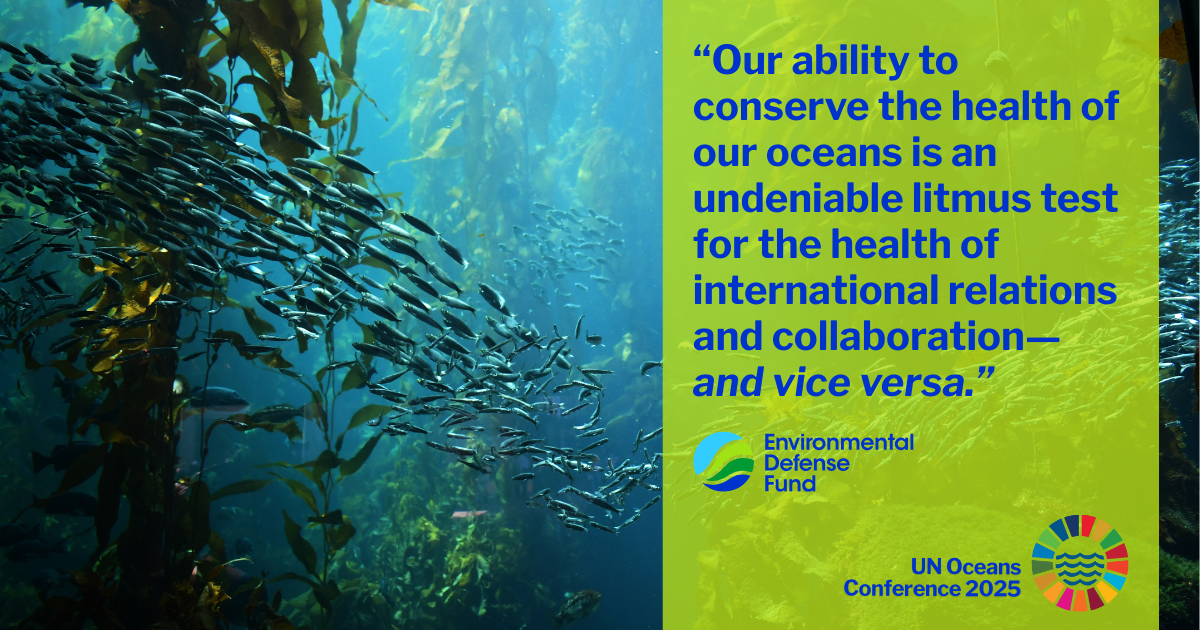Climate Change Threatens Chemical Composition of the Oceans
 The recent U.N. Climate Change conference in Copenhagen highlighted the range of challenges associated with fighting climate change, from cutting energy use to financing clean technology in developing countries. Why the global sense of urgency and focus? Because the impacts of climate change are already being felt. Most of our discussions center on the dangers of sea level rise, which is already inundating low-lying islands and valuable wetlands; on changes in precipitation and air temperature, which will affect everything from agriculture to asthma; and on the shift in seasons and habitat that will make life difficult for trees, butterflies, and the other wildlife we are familiar with.
The recent U.N. Climate Change conference in Copenhagen highlighted the range of challenges associated with fighting climate change, from cutting energy use to financing clean technology in developing countries. Why the global sense of urgency and focus? Because the impacts of climate change are already being felt. Most of our discussions center on the dangers of sea level rise, which is already inundating low-lying islands and valuable wetlands; on changes in precipitation and air temperature, which will affect everything from agriculture to asthma; and on the shift in seasons and habitat that will make life difficult for trees, butterflies, and the other wildlife we are familiar with.
Enormous threats indeed. And it is perhaps inevitable that we are focused on the land and our fellow terrestrial inhabitants. But let us not forget the fact that we are changing the ocean profoundly in many ways. A recent study suggests that over a third of the entire ocean is heavily impacted by human activities, and that there is no longer a single patch of seawater anywhere that can be said to be pristine. And incredibly, we are not just affecting patches of the ocean here or there – we are changing the very chemistry of the seas, chemistry that has remained stable for millennia and which defines the parameters for life in the sea and also for the habitability of the planet for us.
All living systems are buffered from extreme change by their chemistry. If not for the carbonate/bicarbonate and other buffering chemicals in our blood, the pH (a measure of acidity) would fluctuate wildly and none of the myriad proteins or enzymes essential for life would function. Because pH is a logarithmic scale, very small changes in pH can be disastrous for life – for example, a change of less than one pH unit is lethal to humans. 
The ocean is a gigantic living system, and is perhaps one of the best-buffered systems on the planet. Enormous quantities of buffering chemicals have been entering the ocean each year for billions of years. Remarkably, though, even the ocean is not impervious to the impacts of fossil fuel combustion and carbon dioxide emissions.
As atmospheric carbon dioxide concentrations have risen, the ocean has steadfastly taken up about 2 billion tons of it every year, protecting us from an even more serious climate crisis than we have already. However, carbon dioxide reacts with seawater to create carbonic acid. As a result, while the pH of the ocean varies widely in response to local conditions, scientists have detected a noticeable drop in pH (an increase in average acidity) over the last 20 years and project a decrease in pH by 0.3-0.4 units – a huge change – by 2100 if nothing is done to reduce carbon dioxide emissions.
It’s not surprising that such a fundamental change in the ocean is making life difficult for myriad creatures that have evolved under fairly stable conditions. Coral reefs are almost literally melting — it is much harder for corals to make the calcium carbonate shells that protect them and offer shelter to the rich biodiversity typical of reefs under acidic conditions, at the same time as the acidity dissolves their shells. Marine animals ranging from tiny copepods to tasty lobsters and crabs may also face tough times, since their shells also contain carbonates. Many varieties of plankton, the “grass of the sea”, are also vulnerable in an increasingly acidic sea, with potentially disastrous effects on the whole of the ocean’s web of life.
Moreover, as you might expect, as we stuff more and more carbon dioxide into the ocean its ability to take it up is reduced. You can only carbonate soda pop so much, until the gas starts to come out the top of the bottle. Some studies suggest that the ocean’s ability to assimilate our carbon waste may have decreased by about 10% just since in the last 10 years.
What are the implications? We are gambling with a crucial feature of the planet’s life support system – the one that removes wastes, stabilizes the climate, and provides food. Because the ocean is complex and because pH is such a fundamental feature of the ocean, it is difficult to predict exactly what will happen. But it does seem likely that the rate at which we lose coral reefs – already in a precarious predicament due to sea level rise and warming – will increase if the ocean continues to acidify. It also seems safe to project that many, many species will suffer losses in productivity and reproduction and many others will not survive because this change is happening way too fast for them to adapt.
If we are wise, ocean acidification will also cause us to think twice and several times more about pumping carbon into the ocean so we can continue our fossil fuel party, as some have suggested. This may be the worst possible response to ocean acidification: continue to emit carbon dioxide by burning fossil fuels, and inject some of it into the ocean either by stimulating phytoplankton to take it up with fertilizers or artificial upwelling, or pumping it directly in to the ocean. The best response to protect the ocean? Reduce carbon dioxide emissions and do everything we can to reduce the everyday threats to ocean life – pollution, overfishing, and the like – so ocean ecosystems will have the greatest possible scope to deal with acidification and temperature levels that are already “locked in”.
References
Canadell, J.G., C.L. Quere, M.R. Raupach, C.B. Field, E.T. Buitehuis, P. Ciais, T.J. Conway, N.P. Gillett, R.A. Houghton, and G. Marland, Contributions to accelerating atmospheric CO2 growth from economic activity, carbon intensity, and efficiency of natural sinks, Proc. Natl. Acad. Sci. USA, doi 10.1073, 2007.
Anthony KRN, D. I. Kline, G. Diaz-Pulido, S. Dove, and O. Hoegh-Guldberg. Ocean acidification causes bleaching and productivity loss in coral reef buildersPNAS 2008 105:17442-17446; published online before print November 6, 2008, doi:10.1073/pnas.0804478105
Beggs PJ, Bambrick HJ. Is the global rise of asthma an early impact of anthropogenic climate change? Environ Health Perspect. 2005;113 :915 –919[Web of Science][Medline][FindIt@Stanford]
Benjamin S. Halpern, Shaun Walbridge, Kimberly A. Selkoe, Carrie V. Kappel, Fiorenza Micheli, Caterina D’Agrosa, John F. Bruno, Kenneth S. Casey, Colin Ebert, Helen E. Fox, Rod Fujita, Dennis Heinemann, Hunter S. Lenihan, Elizabeth M. P. Madin, Matthew T. Perry, Elizabeth R. Selig, Mark Spalding, Robert Steneck, and Reg Watson (15 February 2008). Science 319 (5865), 948. [DOI: 10.1126/science.1149345]. A meta-analysis shows that human activities have altered virtually all ocean ecosystems, at least to some extent, documenting those areas needing the most protection
Fabry VJ, Brad A. Seibel , Richard A. Feely , and James C. Orr. Impacts of ocean acidification on marine fauna and ecosystem processes. ICES Journal of Marine Science: Journal du Conseil Advance Access published on April 1, 2008, DOI 10.1093/icesjms/fsn048. ICES J. Mar. Sci. 65: 414-432.
Kleypas J A et al 2006 Impacts of Ocean Acidification on Coral Reefs and Other Marine Calcifiers A Guide for Future Research NSF, NOAA US Geological Survey, St Petersburg, FL, 18–20 April
Le Quere, C., C. Rodenbeck, E.T. Buitenhuis, T.J. Conway, R. Langenfelds, A. Gomez, C. Labuschagne, M. Ramonet, T. Nakazawa, N. Metzl, N. Gillett, and M. Heimann, Saturation of the Southern Ocean CO2 sink due to recent climate change, Science, 316 (5832), 1735-1738, 2007.
Orr, James C.; et al. (2005). “Anthropogenic ocean acidification over the twenty-first century and its impact on calcifying organisms”. Nature 437 (7059): 681–686. doi:10.1038/nature04095.
Schuster, U., and A.J. Watson, A variable and decreasing sink for atmospheric CO2 in the North Atlantic, J. Geophysical Res., in press, 2007.
Takahashi T, Stewart C. Sutherland, Colm Sweeney, Alain Poisson, Nicolas Metzl, Bronte Tilbrook, Nicolas Bates, Rik Wanninkhof, Richard A. Feely, Christopher Sabine, Jon Olafsson, Yukihiro Nojiri, Global sea-air CO2 flux based on climatological surface ocean pCO2, and seasonal biological and temperature effects, Deep Sea Research Part II: Topical Studies in Oceanography, Volume 49, Issues 9-10, The Southern Ocean I: Climatic Changes in the Cycle of Carbon in the Southern Ocean, 2002, Pages 1601-1622, ISSN 0967-0645, DOI: 10.1016/S0967-0645(02)00003-6. (http://www.sciencedirect.com/science/article/B6VGC-452W7KK-2/2/cf337375806e31b8c4579d8e5d9a98c7)
Zeebe RE and K Caldeira 2008. Close mass balance of long-term carbon fluxes from ice-core CO2 and ocean chemistry records. Nature Geoscience 1, 312 – 315.













4 Comments
Hi there, I recently published a detailed report on ocean acidification here:
http://climatechangehealth.com/oceans/ocean-acidification/ocean-acidification-major-report
I have also collated several references, videos and reports in this post:
http://climatechangehealth.com/oceans/ocean-acidification/ocean-acidification-resources
Cheers!
Good post, thanks. I like how you describe how we are changing the very chemistry of the seas. And clearly you underscore several ways we all are contributing. At the end you discuss some of the steps needed to be taken. I wonder if you know of actual groups, organizations or companies are are rethinking their practices so they do not continue devastating our seas. I’m thinking of, for example, an organic skincare line whose packaging is made of seeds so there is zero waste or construction companies building and designing so as to limit waste/use more sustainable materials or even groups like EWG who seem to bring awareness to important issues. Obviously, the solutions are not this simple, but instead of highlighting what needs to be done, I wonder if people have concrete examples of practices they live by that are indeed bringing compassion and protection to the chemistry of our seas…
http://bit.ly/neeblog
Paul, thanks for adding additional information.
Hi Carey – thanks for your kind words and thoughtful questions. There is a real thirst for solutions and examples. I detail some in my book Heal the Ocean. EDF also puts out an Innovations Review which describes some really inspiring things that businesses are doing to combat climate change and improve sustainability…http://innovation.edf.org/page.cfm?tagid=1594